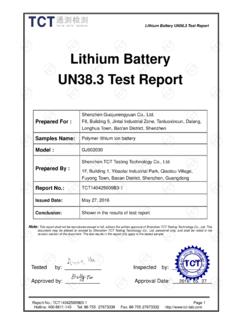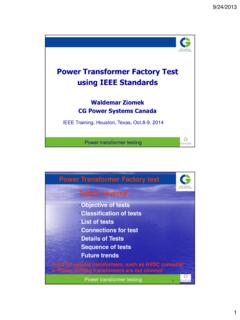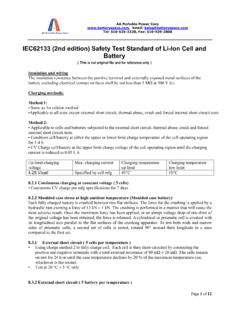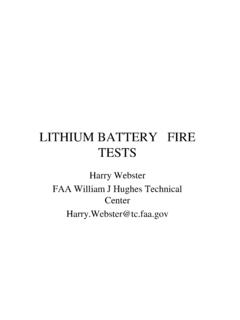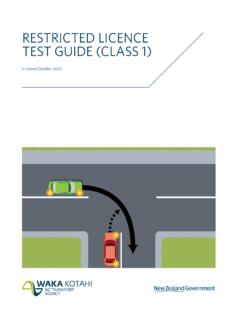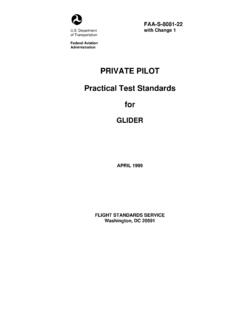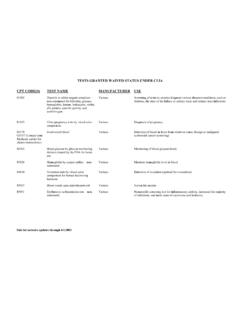Transcription of Westside Test Anxiety Scale - ed
1 1 Westside Test Anxiety Scale Validation by Richard Driscoll, American Test Anxiety Association Abstract The Westside Test Anxiety Scale is a brief, ten item instrument designed to identify students with Anxiety impairments who could benefit from an Anxiety -reduction intervention. The Scale items cover self-assessed Anxiety impairment and cognitions which can impair performance. Correlations between Anxiety -reduction as measured by the Scale and improvements in test performance were used as the validation criteria. Subjects were from two diverse samples: 25 anxious college students, many on academic probation, and 34 anxious fifth grade students.
2 Each sample was divided into Intervention and Control groups, with the Intervention groups receiving an Anxiety -reduction training. Anxiety scores and test scores were attained prior to the study and after Interventions. Anxiety reduction benefits as measured by the Westside Scale correlated .49 and .40 with test gains for the college and fifth grade samples respectively. The average cor-relation was r = 44, indicating that changes in the Westside Scale accounted for 20% of changes in these objective tests . The solid validation coefficient combined with the replication in two diverse student populations indicate that the Westside Scale is a reliable and valid measure of test- Anxiety impairment.
3 As the Scale is brief and easily administered, is public access and free of charge to schools, and is shown to be a reliable and valid measure, it is recommended that the Westside Test Anxiety Scale be considered by intervention programs to screen for test- Anxiety impairments. Introduction Between 15 35 percent of students are adversely affected by high test Anxiety , depending on the criteria for inclusion and the students sampled. Highly anxious students score about 12 percentile points below their low- Anxiety peers (Hembree, 1988), making test Anxiety one of the more serious academic handicaps among students today.
4 School programs to reduce test- Anxiety impairment need an instrument to identify those students who are anxious and might benefit from an Anxiety -reduction intervention, with some assurance that the instrument properly identifies test- Anxiety impairments. 2 The Westside Test Anxiety Scale is an extremely brief screening instrument meant to identify students with Anxiety impairments. The Scale is comprised of ten items, and takes about five to eight minutes to administer. It has been used by school counselors over several years, and has been the primary Anxiety measure in three research projects.
5 The aim of the present investigation is to validate the instrument, so school programs can better understand its properties and have confidence in its applications. Method Content validity While test Anxiety is ordinarily considered to include physiological over-arousal, along with cognitions including dread, worry, and expectations of catastrophic failure, schools are most interested in the impairment aspect of the condition. Excessive test Anxiety often contributes to impaired test performance, and the term "test Anxiety " is commonly used to refer to the Anxiety and its accompanying impairment (Hembree, 1988).
6 Worry and dread are thought to interfere with concentration and are closely asso-ciated with impairment, while over-arousal without the worry features is only loosely associated with impairment (Deffenbacher, 1980; Cassady and Johnson, 2001). To assess test- Anxiety impairment, therefore, it seems reasonable to include cognitive worry items, but not physiological over-arousal items, and to combine these items with self-assessed performance impairment items. The Westside Scale combines six items assessing impairment, four items on worry and dread, and no items on physiological over-arousal.
7 The cognitive items are similar to those in the Cassady-Johnson (2001) Cognitive Test Anxiety Scale and in other familiar Anxiety scales, and the impairment items are similar to those on the Alpert-Haber (1960) Debilitative Anxiety Scale . The Westside Scale thus has high face validity, in that it includes the highly relevant cognitive and impairment factors but omits the marginally relevant over-arousal factor. Change scores Validation is traditionally accomplished by showing that a test Anxiety instrument identifies students with lower test performance, or that it correlates with established instruments that are already considered validated.
8 The excellent Cognitive Test Anxiety Scale by Cassady and Johnson (2001) attained r = .25+ correlations to course test scores, accounting for a respectable 7 8% of the test variance. Yet fully 25% of the variance could be accounted for by the scores on a prior course exam, and the Scale could not improve upon the predictive power of that prior exam. 3 Use of change scores should provide a significant advantage. We should have more confidence in a Scale if it could be shown that changes in the test- Anxiety scores are closely related to changes in test performance.
9 As test- Anxiety scores decrease, we should find that test performance improves (and vice versa). So far as a test Anxiety Scale is a valid measure of test impairment, then variations in that Scale should move together with variations in test performance (other factors being equal). The current investigation looks at two Anxiety -reduction intervention studies, already published, and correlates changes in the Westside Scale scores to changes in objective test results. The two studies assigned students to Intervention and Control groups, admin-istered an Accelerated Desensitization & Adaptive Attitudes Training (Driscoll, 2006) to the Intervention students, and assessed the results.
10 Results A 2004 intervention with anxious college students included 20 students, half on academic probation, assigned in equal proportion to Intervention and Control groups (Driscoll, Holt, & Hunter, 2005). Students took midterm exams, the Intervention students reviewed the ADAA Training an average of twice, and students took finals. The test change scores were the finals scores minus the midterm scores. Test scores improved an average of 18 percentile points for the Intervention students over the controls. Anxiety change scores were obtained from 11 of the students, and the Anxiety -reduction benefits were substantial.










